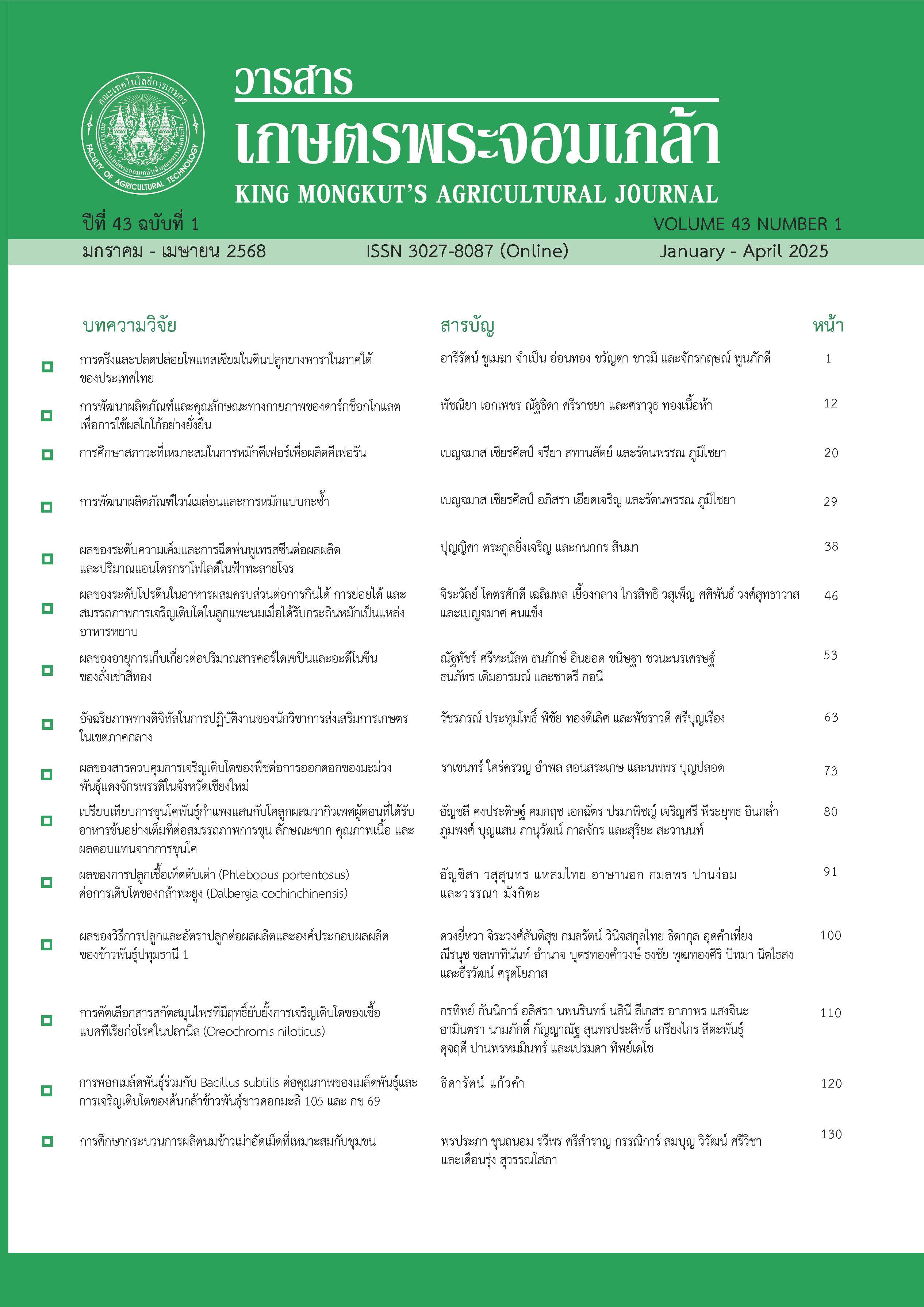Optimization of Kefir Fermentation for Kefiran Production
Main Article Content
Abstract
Kefir is native fermented milk derived from the Caucasian. It has sour taste and alcoholic qualities caused by the fermentation of yeast and bacteria embedded in kefir grain. By fermenting the kefir, lactic acid bacteria in the grain produce the viscous polymer called kefiran. Kefiran was produced from kefir grains via fermentation with coconut juice or fresh milk. It was found that kefir grains in milk produced higher amounts of kefiran and lactic acid than kefir grains in coconut juice while kefir grains in coconut juice produced higher amount of ethanol. It was also found that at 30ºC, kefir grains in coconut juice produced higher amount of kefiran, lactic acid and ethanol than at 37 °C. Additionally, the initial seed inoculum of kefir grains in milk at 1% of kefir grain wet weight by milk volume in static condition yielded the highest amount of kefiran at 73.63 mg per 120 mL of milk. The optimal conditions obtained in this study may contribute to the production of kefiran through kefir fermentation.
Article Details

This work is licensed under a Creative Commons Attribution-NonCommercial-NoDerivatives 4.0 International License.
King Mongkut's Agricultural Journal
References
Apar, D. K., Demirhan, E., Özel, B., & Özbek, B. (2017). Kefir grain biomass production: Influence of different culturing conditions and examination of growth kinetic models. Journal of Food Process Engineering, 40(1), e12332.
Arslan, S. (2015). A review: chemical, microbiological and nutritional characteristics of kefir. CyTA-Journal of Food, 13(3), 340-345.
Cheirsilp, B., & Radchabut, S. (2011). Use of whey lactose from dairy industry for economical kefiran production by Lactobacillus kefiranofaciens in mixed cultures with yeasts. New Biotechnology, 28(6), 574-580.
Cheirsilp, B., Shoji, H., Shimizu, H., & Shioya, S. (2003). Interactions between Lactobacillus kefiranofaciens and Saccharomyces cerevisiae in mixed culture for kefiran production. Journal of Bioscience and Bioengineering, 96(3), 279-284.
Dailin, D. J., Elsayed, E. A., Othman, N. Z., Malek, R. A., Ramli, S., Sarmidi, M.R., Aziz, R., Wadaan, M. A., & El Enshasy, H. A. (2015). Development of cultivation medium for high yield kefiran production by Lactobacillus kefiranofaciens. International Journal of Pharmacy and Pharmaceutical Sciences, 7(3), 159-163.
Dimitreli, G., Exarhopoulos, S., Goulas, A., Antoniou, K. D., & Raphaelides, S. N. (2016). Effect of kefiran and milk proteins addition on the rheological behavior of glucono-deta-lactone induced milk gels. Journal of Food Research, 5(1), 121-128.
Fels, L., Jakob, F., Vogel, R. F., & Wefers, D. (2018). Structural characterization of the exopolysaccharides from water kefir. Carbohydrate Polymers, 189(1), 296-303.
Laureys, D., & De Vuyst, L. (2017). The water kefir grain inoculum determines the characteristics of the resulting water kefir fermentation process. Journal of Applied Microbiology, 122(3), 719-732.
Setiawati, A. E., Sari, I. N. I., & Hasyati, N. (2021). Effect of temperature and time storage towards alcohol level in cow milk kefir. In International Conference on Green Agro-industry and Bioeconomy, pp. 012108. Faculty of Agricultural Technology, Universitas Brawijaya.
Suksawang, S., Cheirsilp, B., & Yeesang, J. (2016). Production of kefiran from molasses and spent yeast cells by Lactobacillus kefiranofaciens JCM 6985. Asia-Pacific Journal of Science and Technology, 21(2), 59–67.
Zajšek, K., & Goršek, A. (2010). Mathematical modelling of ethanol production by mixed kefir grains yeast population as a function of temperature variations. Biochemical Engineering Journal, 49(1), 7-12.
Zajšek, K., Goršek, A., & Kolar, M. (2013). Cultivating conditions effects on kefiran production by the mixed culture of lactic acid bacteria imbedded within kefir grains. Food Chemistry, 139(1-4), 970-977.

